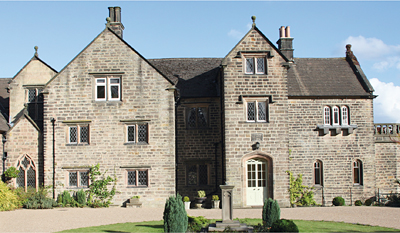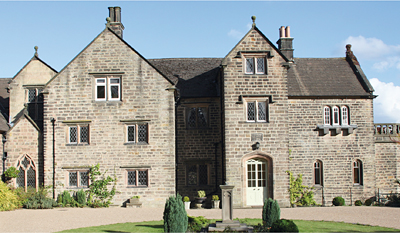Florence Nightingale’s childhood home for sale
Penny Churchill explores the superb Derbyshire childhood home of Florence Nightingale amongst the houses for sale in the county


Set high on the eastern slopes of Derbyshire's glorious Derwent valley, Lea Hurst at Holloway, near Matlock, was the much-loved childhood home of Florence Nightingale, and the haven she returned to after the Crimean War. After 50 years as a home for the elderly, a rundown Lea Hurst, listed Grade II, was sold due to lack of funds in 2004. A year or so later, it was bought by property developer Robert Mountford Aram, an avid collector and restorer of artefacts and buildings linked to Derbyshire's industrial heritage, including the showpiece Masson Mills at Matlock Bath, built by Sir Richard Arkwright in 1783. Five years on, Lea Hurst, authentically restored to the charming family home it once was, is back on the market at a guide price of £2.45 million through Derbyshire agents Caud-well & Co (01629 810018).
In the early 1700s, Thomas Nightingale, a rich lead merchant, bought the 640-acre estate and manor of Lea, and rebuilt Lea Hall. In 1771, his second son, Peter, bought Lea Hurst with 1,381 acres of land, and, in 1784, created a cotton-spinning factory at Lea Bridge, based on Richard Arkwright's successful Cromford Mill nearby. Peter Nightingale died without issue in 1813, leaving Lea Hurst and its estate to his nephew William Shore, who took the name of Nightingale in order to claim his inheritance. A few years later, the scholarly William married and went abroad, where his wife gave birth to two daughters, Parthenope and Florence, each named after her birthplace.

* For more properties like this every week, subscribe and save
The family returned to England in 1821, and William set about enlarging Lea Hurst, completing the work in 1825. But he allegedly found the house ‘too cold, too small and too isolated from society', and, shortly afterwards, bought rambling Embley Park at Wellow, Hampshire, where the family lived thereafter for much of the year, returning to Lea Hurst only for the summer. Florence loved their Derbyshire retreat, which she fondly describes as ‘a small house with only 15 bedrooms', of which she later wrote, ‘it breaks my heart to leave Lea Hurst'.
In 1854, while Florence was away in the Crimea, the novelist Elizabeth Gaskell was struggling to finish North and South for her impatient publisher Charles Dickens, and spent some weeks at Lea Hurst. She was entranced by the view from the window of Florence's study: ‘First a garden with stone terraces and flights of steps and old stone columns with globes at the top of them... then a sloping meadow, losing itself in a steep wooded descent to the Derwent.' The same view can be seen today from Florence's newly renovated bedroom suite, which includes her former study. On returning from the war in 1856, Florence shunned publicity and walked unnoticed from nearby Whatstandwell station to Lea Hurst, carrying her own suitcase.
By 1860, she was living in a flat in London while overseeing the newly founded Nightingale Training School for Nurses at St Thomas's infirmary; in 1865, she moved to 35, South Street, Mayfair, where she lived until her death in 1910, aged 90. All links with Lea Hurst were severed following her mother's death in 1880, although the house remained in her extended family until the mid 1940s, and was eventually bought by The Royal Surgical Aid Society in 1951.
The renovation of Lea Hurst has been a major undertaking, involving the removal of institutional doors, partition walls and stair-lifts, the refurbishment of the old industrial kitchens, and the demolition of a glazed walkway linking the nearby coach house to the main building. Set in 19.4 acres of Victorian gardens and grounds, it now has a welcoming entrance hall (complete with portrait of Peter Nightingale), four/five reception rooms, a billiard room and a kitchen/breakfast room, plus five first-floor bedrooms, three bathrooms, two studies, and three unconverted attic rooms-the former nursery in Florence Nightingale's day.
Sign up for the Country Life Newsletter
Exquisite houses, the beauty of Nature, and how to get the most from your life, straight to your inbox.
In an intriguing postscript to the restoration, Lea Hurst was used by the BBC as the setting for its TV programme on Florence Nightingale's life screened in 2008, in which the cameo role of the doctor was played by Mr Aram. After the Crimean War, the Lady with the Lamp was a regular visitor to The Heath House at Tean, Staffordshire, ancestral home of John Burton Philips, whose 60 rooms would have made Lea Hurst feel small indeed.
Smaller than The Heath House, but imposing nonetheless was nearby Hollington Hall at Hollington, on the Staffordshire/Derbyshire border, which was built in the 1860 by Victorian church architect Ewan Christian as a wedding present for Burton Philips's son, Edward. The tiny village of Hollington overlooks the scenic Dove valley and is probably best known for the creamy local stone used in the construction of Hollington Hall and numerous important buildings, including the new Coventry Cathedral. Recently refurbished by its present owners, Hollington Hall is for sale with 5½ acres of gardens and grounds at a guide price of £1.975m through Fisher German (01530 412821) and Knight Frank (0121-200 2220).
The tall, gabled, 9,182sq ft house has a grand reception hall with an oak-boarded floor and an elegant turret staircase. Radi-ating off the hall are the main reception rooms: drawing room, dining room and library. The heart of the house is a vast open space taken up by a huge kitchen and breakfast room adjoining an inner hall and playroom, the whole area completed by a newly converted wing that provides an impressive entertaining space of magnificent proportions. The first floor houses a grand master suite, five good-sized bedrooms, a large sitting room/office, and four bath/shower rooms. At present the extensive second floor comprises two double bedrooms, a shower room, a games room and a study.
Across the courtyard from the main house is the charming, two-bedroom Old School House, originally built by Mr Philips for the private schooling of five of his children. The main gardens lie to the south and east of the house with extensive lawns, interspersed with mature trees and rhododendrons, leading out to the ha-ha on the boundary. The remainder of the land is split into paddocks where a neat stable block provides three loose boxes and a tack room.
Country Life is unlike any other magazine: the only glossy weekly on the newsstand and the only magazine that has been guest-edited by HRH The King not once, but twice. It is a celebration of modern rural life and all its diverse joys and pleasures — that was first published in Queen Victoria's Diamond Jubilee year. Our eclectic mixture of witty and informative content — from the most up-to-date property news and commentary and a coveted glimpse inside some of the UK's best houses and gardens, to gardening, the arts and interior design, written by experts in their field — still cannot be found in print or online, anywhere else.
-
 Six rural properties with space, charm and endless views, as seen in Country Life
Six rural properties with space, charm and endless views, as seen in Country LifeWe take a look at some of the best houses to come to the market via Country Life in the past week.
By Toby Keel Published
-
 Exploring the countryside is essential for our wellbeing, but Right to Roam is going backwards
Exploring the countryside is essential for our wellbeing, but Right to Roam is going backwardsCampaigners in England often point to Scotland as an example of how brilliantly Right to Roam works, but it's not all it's cracked up to be, says Patrick Galbraith.
By Patrick Galbraith Published
